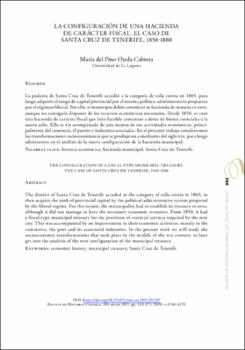La configuración de una hacienda de carácter fiscal. El caso de Santa Cruz de Tenerife, 1850-1880
Date
2019Abstract
La pedanía de Santa Cruz de Tenerife accedió a la categoría de villa exenta en 1803, para
luego adquirir el rango de capital provincial por el sistema político-administrativo propuesto
por el régimen liberal. Por ello, el municipio debió constituir su hacienda de manera ex novo,
aunque no consiguió disponer de los recursos económicos necesarios. Desde 1850, se creó
una hacienda de carácter fiscal que hizo factible comenzar a dotar de bienes esenciales a la
nueva urbe. Ello se vio acompañado de una mejora de sus actividades económicas, principalmente
del comercio, el puerto e industrias asociadas. En el presente trabajo estudiaremos
las transformaciones socioeconómicas que se produjeron a mediados del siglo xix, para luego
adentrarnos en el análisis de la nueva configuración de la hacienda municipal. The district of Santa Cruz de Tenerife acceded to the category of villa exenta in 1803, to
then acquire the rank of provincial capital by the political-administrative system proposed
by the liberal regime. For this reason, the municipality had to establish its treasury ex novo,
although it did not manage to have the necessary economic resources. From 1850, it had
a fiscal-type municipal treasury for the provision of essential services required by the new
city. This was accompanied by an improvement in their economic activities, mainly in the
commerce, the port and its associated industries. In the present work we will study the
socioeconomic transformations that took place in the middle of the xix century, to later
get into the analysis of the new configuration of the municipal treasury.






